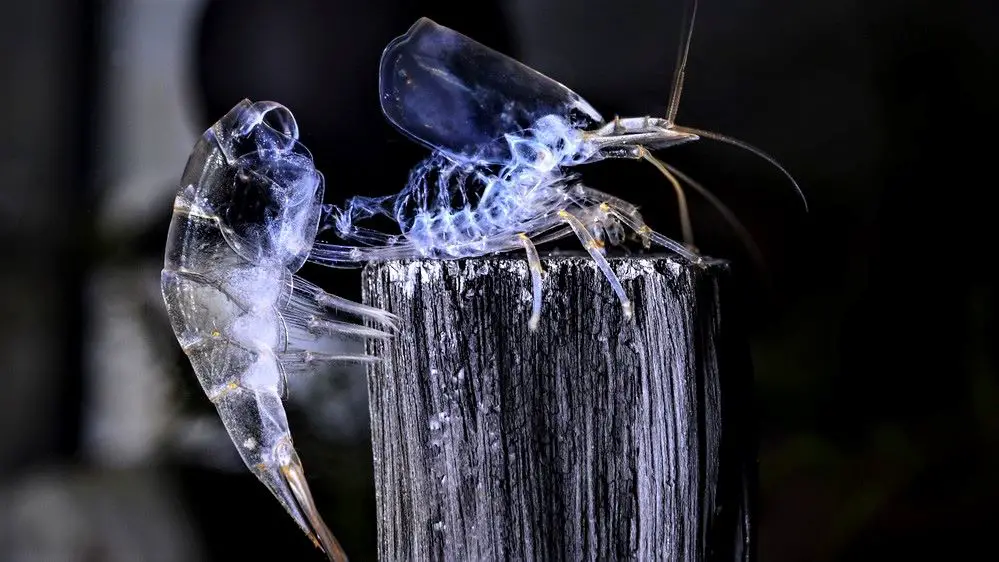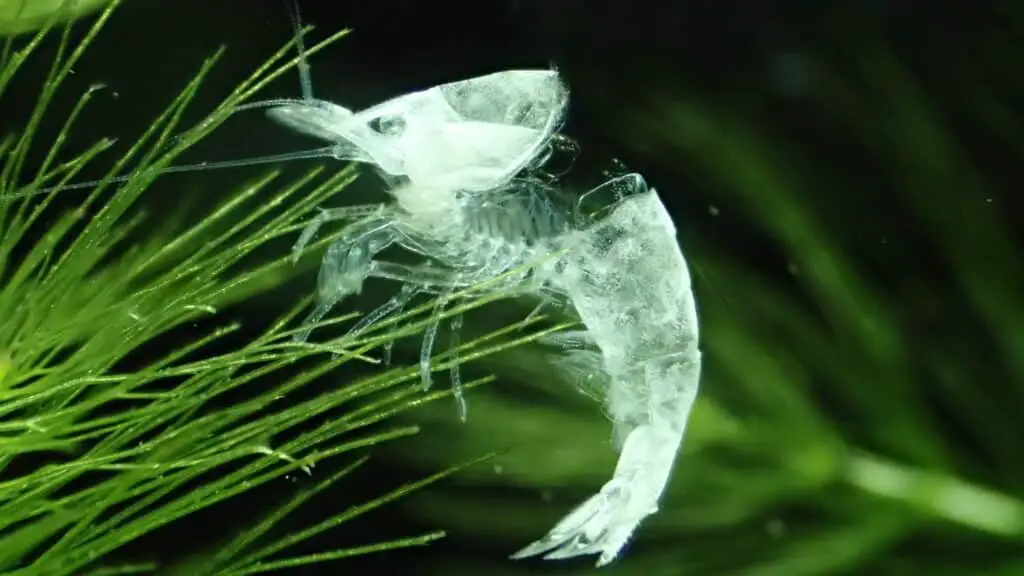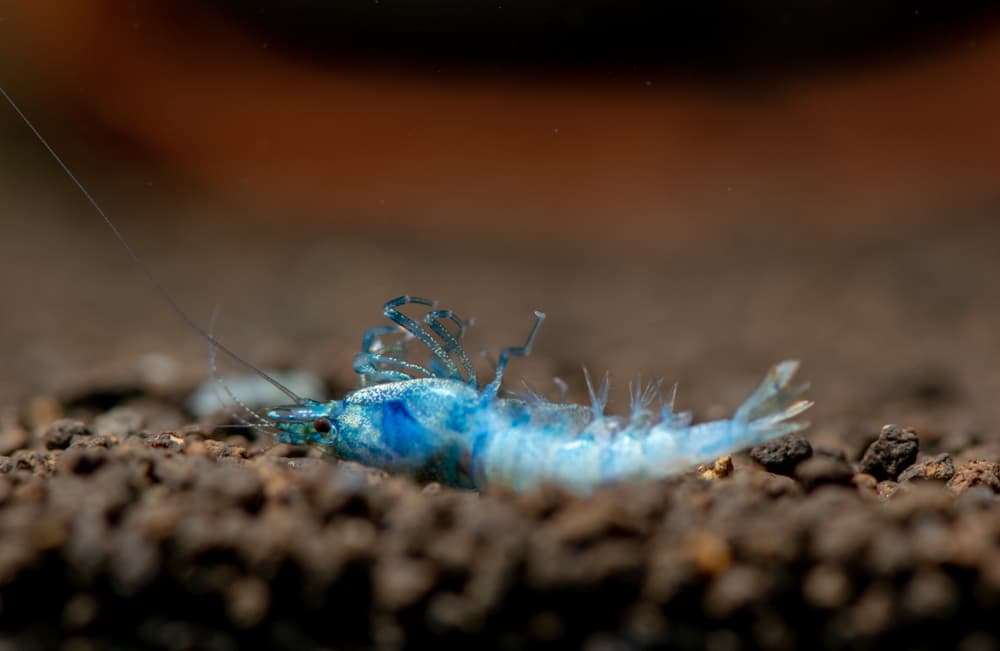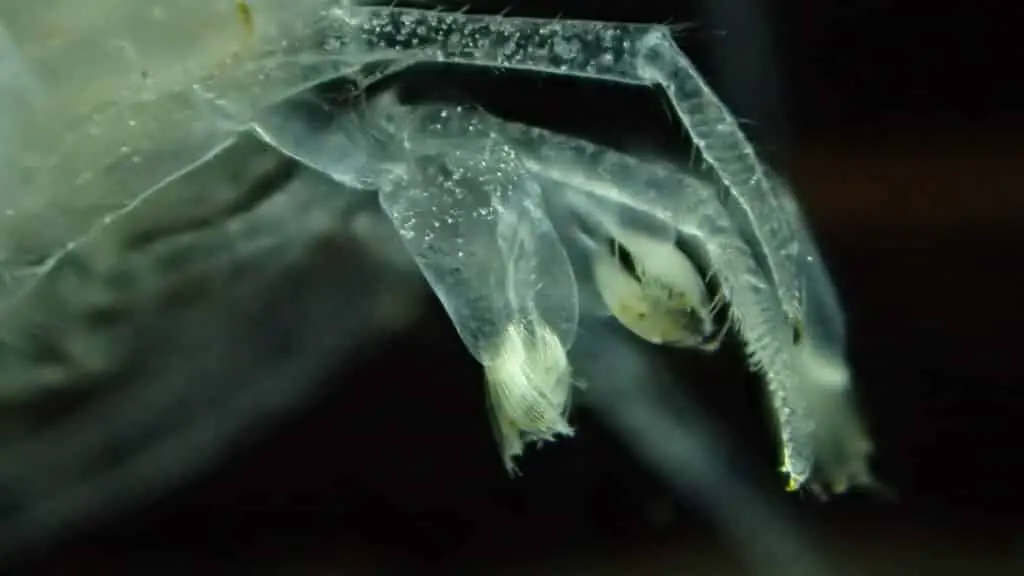It can be challenging to differentiate between a molting shrimp and a deceased one. However, there are key signs to look for. A molting shrimp tends to go into hiding and may be seen rubbing itself with its hind legs. Its molt is often white and appears like an exploded shell. Conversely, a dead shrimp typically turns pink, resembling cooked shrimp, and its body doesn’t look like an ‘exploded’ shell.
Have you ever found yourself puzzled, gazing into your aquarium at an odd-looking shrimp? I know I have. There are moments when you can’t tell if your shrimp is going through a natural molting process or if it’s met its untimely end. I’ve had my fair share of these instances, which’ve always been a learning experience.
While it can be quite alarming at first, I’ve found that there are clear signs to help differentiate between a molting shrimp and a deceased one. The process of molting is fascinating and understanding it can help put your mind at ease when you see your shrimp in what may initially appear to be a compromising position.
Throughout this article, I’ll share my experiences and insights to help you better understand what to look for when your shrimp is molting and how to differentiate this from the unfortunate event of a shrimp’s demise. We’ll explore a shrimp’s different behaviors and visual cues during its molting process and how these contrast with a shrimp that has passed on.

The Shrimp Molting Process
The molting process is a natural and vital part of a shrimp’s life cycle. It’s how they grow and regenerate their hard exoskeleton, which does not expand as the shrimp’s body grows. A shrimp molts throughout its lifetime, and the frequency can vary based on factors such as age, diet, water quality, and stress levels.
Molting begins internally before any visible signs appear. The shrimp starts to develop a new, soft exoskeleton under the current, hard one. The old shell begins to separate from the new one in a process called apolysis. During this stage, the shrimp absorbs water, causing its body to swell and further separate the old shell from the new one underneath.
At the same time, the shrimp secretes enzymes to break down the inner layer of the old shell, making it easier to remove. This process can make the shrimp appear slightly cloudy or discolored due to the new exoskeleton’s color showing through.
When the time comes for the shrimp to shed its old shell, it typically finds a safe place to hide, instinctively seeking protection as it will be vulnerable during and immediately after molting. The shrimp will then flex its body to crack the old shell along the back. Once the shell has split, the shrimp can slide out, often leaving the old shell fully intact.
After molting, the shrimp’s new exoskeleton is soft and needs time to harden or ‘cure’. During this time, the shrimp continues to hide to avoid predation as it’s vulnerable until its new shell hardens.
Understanding this process can be incredibly beneficial, especially when it comes to differentiating between a molting shrimp and a deceased one. The more familiar you are with the molting process, the easier it becomes to identify the signs and put your worries to rest when you spot a discarded shell in your tank.
Signs that Your Shrimp is Molting
Recognizing the signs that your shrimp is about to molt can help alleviate concerns about its health. These signs, both behavioral and physical, can serve as a heads up that your shrimp is about to undergo this critical process.
Behavioral Changes: One of the most common signs that your shrimp is about to molt is a change in behavior. Shrimp, generally active and visible, might start to behave unusually. You might notice your shrimp hiding more often than usual, especially if your tank is equipped with plenty of hiding spots. This behavior is instinctual – they are seeking a safe place to go through the vulnerable molting process. If your shrimp is more reclusive, do not be alarmed – it’s likely gearing up for a molt.
Physical Changes: In addition to behavioral changes, there are physical signs that a molt is imminent. Shrimp may appear slightly cloudy or discolored as the new exoskeleton forms underneath the old one. Some shrimp also tend to eat more than usual in the lead-up to a molt as they require additional nutrients for the process.
Presence of Molted Shell: The most definitive sign that your shrimp has molted is the presence of an empty exoskeleton. These discarded shells often look like a translucent, white, or slightly gray version of the shrimp and can easily be mistaken for a dead shrimp at first glance. However, upon closer inspection, you’ll notice that it’s hollow and almost appears like it’s been ‘blown up’. It’s crucial to remember that the presence of an exoskeleton does not mean the shrimp is dead – in fact, it’s quite the opposite!
Post-Molt Behavior: After molting, shrimp often remain hidden until their new exoskeleton hardens. They may also consume their discarded shell to regain some of the valuable nutrients lost during the molt. So if you see your shrimp munching on a seemingly empty shell, that’s a good sign – it’s just had a successful molt!
By familiarizing yourself with these signs, you can better understand what’s happening with your shrimp and ensure they are healthy and thriving.

Distinguishing Molting from Death: Key Visual Differences
Distinguishing between a molting shrimp and a deceased one can be a challenge, especially for novice aquarium enthusiasts. However, there are key visual differences that can help you determine the state of your shrimp.
Coloration: One of the most striking differences between a molting shrimp and a dead one is the coloration. A molted shell tends to be transparent or whitish-gray in color, resembling an ‘exploded’ shrimp. It’s often hollow and can be seen lying intact on the substrate of your tank.
On the other hand, a dead shrimp usually undergoes a noticeable change in coloration. It often turns a pinkish hue, similar to the color of cooked shrimp. This color change is due to the breakdown of pigments in the shrimp’s body after death. If your shrimp turns this pinkish color, it’s unfortunately likely that it has passed away.
Shape and Structure: Another distinguishing feature is the shape and structure of the shrimp. A molting shrimp leaves behind a shell that looks very much like the shrimp itself – so much so that it can easily be mistaken for a dead shrimp. However, this shell is often hollow and appears slightly ‘inflated’.
In contrast, a dead shrimp does not retain its full, ‘inflated’ shape. Instead, it may appear shrunken or collapsed as the body begins to decay. The legs and antennae often lose their rigidity and hang limp.
Location and Behavior: Lastly, the shrimp’s behavior and location in the tank can also provide clues. A molting shrimp will typically find a safe place to hide and may seem less active. After molting, the shrimp may reappear, appearing a bit brighter in color due to the new exoskeleton.
In contrast, a dead shrimp is typically immobile and may be found lying on the tank substrate without any signs of movement over an extended period. Dead shrimp often also float to the surface of the tank, while molted shells usually remain on the bottom.
By keeping an eye out for these key visual differences, you can accurately determine whether your shrimp is merely molting or if it has unfortunately passed away. Remember, molting is a natural and healthy process for shrimp, and understanding this can help alleviate any concerns you might have when you see a shrimp-like shell in your tank.

Shrimp Behavior During Molting
The molting process can dramatically affect a shrimp’s behavior, with these changes serving as key indicators that molting is underway. Understanding these behavioral shifts can help you identify when your shrimp is about to molt, during molting, and post-molting.
Pre-Molting Behavior: Before molting, shrimp tend to change their behavior noticeably. They may start to eat more as they prepare for the energy-intensive molting process. They also tend to become less active and more reclusive. It’s common for shrimp to seek hiding places in the tank as they instinctively try to protect themselves during this vulnerable period.
Molting Behavior: When the actual molting process begins, the shrimp often remains stationary and may be seen rubbing itself with its hind legs. This behavior helps to break the old exoskeleton and facilitate its removal. Once the old shell has cracked open, the shrimp wriggles its body and slides out. This process is usually quite quick, and you might not even notice it unless you’re observing your tank at the right moment.
After the old shell is shed, you might see what looks like an ‘exploded’ shrimp shell. This is the discarded exoskeleton, and it’s a clear sign that your shrimp has just molted.
Post-Molting Behavior: Immediately after molting, the shrimp’s new exoskeleton is soft, leaving it vulnerable to predation. To avoid potential threats, the shrimp usually remains hidden until the new shell hardens – a process that can take a few hours to a couple of days depending on the shrimp’s size and species.
During this time, the shrimp may also consume its discarded exoskeleton. This behavior might seem unusual, but it’s perfectly normal. The old shell contains valuable nutrients like calcium, which the shrimp reabsorbs to help harden the new exoskeleton.
By understanding these behavioral changes, you can better anticipate when your shrimp is about to molt, identify when it’s happening, and ensure you’re providing the right conditions for your shrimp to safely go through this essential process.

What Happens When a Shrimp Dies?
Just as understanding the molting process is crucial for shrimp keepers, it’s equally important to recognize the signs and aftermath when a shrimp unfortunately dies. This can help you promptly deal with the situation to prevent potential issues such as water quality degradation and disease spread.
Physical Changes: When a shrimp dies, it undergoes significant physical changes. One of the most noticeable changes is in coloration. A dead shrimp often turns a pinkish hue, similar to the color of cooked shrimp. This happens because of the breakdown of pigments in the shrimp’s body after death.
The body structure of a dead shrimp changes too. Unlike the ‘inflated’ appearance of a molted shell, a dead shrimp may appear shrunken or collapsed as the body begins to decompose. The rigidity of the shrimp’s legs and antennae is lost, and they often hang limp.
Location and Behavior: A dead shrimp is typically found immobile and can be seen lying on the tank substrate or floating at the surface of the water. Unlike a molting shrimp, which may hide and then reappear more vibrant, a dead shrimp shows no signs of movement over an extended period.
Impact on the Aquarium Environment: If a shrimp dies and is not removed promptly, it can start to decay, which can affect the water quality in your tank. Decomposition leads to an increase in ammonia levels, which can be harmful or even lethal to other inhabitants of the tank.
If you notice a dead shrimp in your tank, it’s important to remove it as soon as possible to prevent any potential negative effects on the water quality and other tank inhabitants. Additionally, it would be wise to check the water parameters and observe other tank inhabitants closely to identify any potential issues that could have contributed to the shrimp’s death.
While it can be disheartening to lose a shrimp, understanding what happens when a shrimp dies can help you respond appropriately to maintain a healthy and safe environment for your other aquatic pets.

Creating a Safe Environment for Molting Shrimp
Molting is a crucial part of a shrimp’s life cycle, and creating a safe and supportive environment for this process is essential for the well-being of your shrimp. Here are some factors to consider when setting up and maintaining a safe environment for molting shrimp.
Provide Plenty of Hiding Places: When shrimp are about to molt, they instinctively seek out hiding places to protect themselves during this vulnerable period. Providing plenty of hiding places in your tank can help your shrimp feel safe and secure. You can use decorations, plants, rocks, or specially-designed shrimp hides to create these safe spaces.
Maintain Optimal Water Conditions: Stable and optimal water parameters are vital for a successful molt. Sudden changes in water temperature, pH, or salinity can stress your shrimp and may cause molting issues. Regularly monitor your water parameters and perform partial water changes as needed to maintain a stable environment.
Ensure Adequate Nutrition: Shrimp require certain nutrients, such as calcium and iodine, for the development and hardening of their new exoskeleton. Make sure to feed your shrimp a balanced diet that includes these essential nutrients. The addition of a mineral supplement to the tank can also be beneficial.
Minimize Stress: High stress levels can lead to molting problems in shrimp. Minimizing disturbances, maintaining a stable environment, and keeping predatory fish away from your shrimp can significantly reduce stress levels.
Observe and Respect the Molting Process: If you observe your shrimp molting, try not to interrupt the process. It can be tempting to interfere, especially if the process seems to be taking longer than expected, but patience is key. Your shrimp knows what it’s doing!
By keeping these considerations in mind, you can provide a supportive environment for your shrimp to molt safely. Remember, molting is a sign of growth and health in shrimp, so creating a space where this can happen naturally and comfortably is a significant part of successful shrimp keeping.
Conclusion
Whether you’re a seasoned aquarist or a beginner just starting out, understanding the behavior and needs of your shrimp can greatly enhance their well-being and your overall aquarium experience. Though initially confusing, the molting process is a natural and healthy part of a shrimp’s life cycle. By learning to distinguish between a molting shrimp and a deceased one, you’ll become more attuned to your shrimp’s needs and behaviors.
Likewise, understanding the behaviors associated with molting can provide you with valuable insight into this fascinating process. From the pre-molting signs of increased seclusion and food intake to the post-molting behaviors of hiding and shell consumption, these behavioral shifts are essential for a successful molt.
Creating a safe and comfortable environment for your shrimp to molt is equally important. Providing plenty of hiding places, ensuring optimal water conditions, and supplying a balanced diet rich in essential nutrients are key strategies to support your shrimp during molting.
On the other hand, recognizing the signs when a shrimp has unfortunately passed away is vital to maintaining a healthy aquarium environment. Prompt removal of deceased shrimp can prevent water quality issues and potential disease spread, contributing to the overall well-being of your tank’s ecosystem.
In the end, keeping shrimp can be an incredibly rewarding hobby. Each molt signifies a new stage of growth, symbolizing the ongoing life cycle within your home aquarium. And while death is an inevitable part of this cycle, understanding and responding to it appropriately can ensure the continued health and vitality of your remaining aquatic pets.
So, here’s to the joy of shrimp keeping—may your understanding of these tiny, fascinating creatures continue to deepen, and may your aquarium thrive with life, growth, and discovery!
Happy Shrimp Keeping Shrimpfam!
FAQ Section
1. How can I tell if my shrimp is molting or dead?
Distinguishing between a molting shrimp and a dead one can be done by observing several key differences. A molting shrimp will often leave behind a white, ‘inflated’ exoskeleton that resembles a whole shrimp, whereas a dead shrimp will typically turn a pinkish color and may appear shrunken or collapsed. The behavior and location of the shrimp can also provide clues. A molting shrimp may hide and become less active before reappearing, while a dead shrimp will show no signs of movement over an extended period.
2. How often do shrimp molt?
The frequency of molting can depend on several factors, including the shrimp’s age, species, and overall health. Young shrimp tend to molt more frequently than adults as they are growing at a faster rate. On average, shrimp may molt every 3-8 weeks.
3. What should I do if I see a molted shell in my aquarium?
If you see a molted shell in your aquarium, there’s usually no need to remove it. Shrimp often consume their molted shells to reabsorb valuable nutrients, like calcium, which help harden their new exoskeleton. If the shell remains untouched for a few days, you can remove it to keep your tank clean.
4. My shrimp has been hiding for a few days. Is it molting or is it sick?
While hiding can be a sign that your shrimp is about to molt, prolonged hiding can also be a sign of stress or illness. If your shrimp continues to hide for several days, shows other signs of illness such as lack of appetite or unusual behavior, or if other tank inhabitants are also showing signs of stress, it would be a good idea to check your water parameters and consider consulting a vet or an aquarium expert.
5. What should I do if my shrimp dies?
If a shrimp dies in your tank, it’s important to remove it as soon as possible to prevent the decomposition process from affecting your water quality. After removing the dead shrimp, check your water parameters, and observe other tank inhabitants closely to identify any potential issues that could have contributed to the shrimp’s death.
6. How can I make the molting process easier for my shrimp?
You can support your shrimp during the molting process by providing plenty of hiding places in your tank, maintaining optimal water conditions, and ensuring your shrimp has a diet rich in essential nutrients like calcium and iodine. Minimizing disturbances and stress in the tank is also important.
7. Is molting painful for shrimp?
While molting can be a stressful process for shrimp due to their vulnerability during this period, there’s no evidence to suggest that it’s painful. It’s a natural part of their life cycle, much like growing a new set of teeth is for humans. However, ensuring a stress-free environment and proper nutrition can make the process easier for them.
